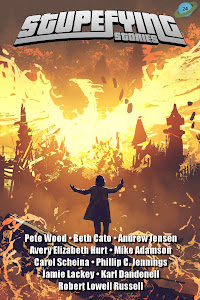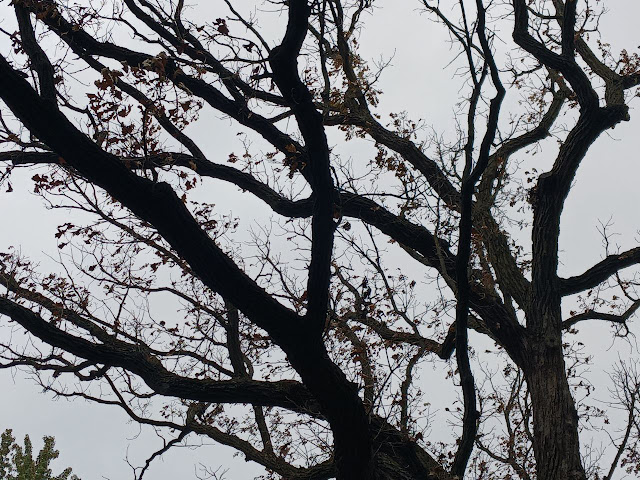We always knew that November 2023 was going to be a difficult month.
The last three years of Karen’s life were challenging. The last three months, horrific. The last three weeks, heartbreaking. The last three days… I don’t have the words. This coming Saturday it will have been one year to the day. Somehow I will get through it, but I don’t know how, just yet. I suspect it will involve my making a giant batch of mostaccioli and totally blowing my carbohydrate budget for December.
I had thought that by throwing myself into work I could build up the momentum to plow through October and November without stopping. Stupefying Stories 26 was too ambitious, though; too big, too exhausting. By the time I’d recovered from getting that behemoth finished and out the door, other things in my life were starting to hit the fan, some of which you already know about and others of which are none of your business. Being forced to take a longer than planned time-out, then, I began to ask questions. Two of the biggest of were:
What exactly am trying to prove here?
What is the point of Stupefying Stories, anyway?
I could answer those questions by quoting our mission statement. I wrote it, after all. But instead, I keep hearing echoes of these other words of mine, from an interview I did with Strange Horizons back in 2005.
LJ: Are you seeing any interesting avenues in which the genre finds itself expanding?
BB: I think it’s a mistake to talk about “the genre” as if it were a monolith. There may have been a time when it was possible for a dedicated fan to read a good sampling of all the new SF being published, but that time—if it ever really was—was long ago. What we’ve been going through for at least the last 30 years has been a sort of literary cladogenesis, with “the genre” fragmenting into dozens of related but distinct daughter-genres and microgenres.
The interesting part of this is that, between print-on-demand publishing, e-publishing, web publishing, and all the other emerging technologies, it’s now at least semi-practical to publish fiction that has no hope of ever appealing to a mass audience. If you wanted to, say, launch an e-zine devoted exclusively to publishing stories about promiscuous centaurs living in trailer parks in Alabama, you could do it, and do a very professional-looking job of it. Not only that, but thanks to the Internet, you would actually stand a pretty fair chance of reaching the 500 people in the world who want to read nothing but stories about promiscuous centaurs living in trailer parks in Alabama. So there’s more fiction being published than ever before.
The downside for the writer, though, is that there’s no money in it. The general interest magazines appear to be following the general interest anthologies into extinction, and extreme specialization and small-niche marketing seem to be the shape of things to come. Readers now have unprecedented power to find only exactly the types of fiction they want to read, without risk of accidental exposure to anything else. I suppose they’ve always had this power—I can think of entire years when I subscribed to Asimov’s and only read two or three stories in each issue—but at least with a general interest magazine, there was always the possibility that after you’d read the Michael Swanwick and Lucius Shepard stories, you might take a chance on Karen Joy Fowler.
But this trend towards extreme narrowcasting—it’s both fascinating and disturbing. When the reader can exercise such fine control over the input he receives, how does a writer crack through that protective shell?
Eighteen years later, the answer seems clear. You can’t. The algorithms have triumphed. Amazon über alles. Not only is Amazon making sure their customers only see ads for stuff just exactly like other stuff they’ve already bought and liked, they’re making sure none of those damned Mississippi centaurs are sneaking in the back door and surprising anyone. The literary omnivore, the “general interest” SF/F reader, while not extinct in the wild quite yet, definitely should be on the endangered species list. There aren’t many left. Maybe we should start a captive breeding program. God knows most of them need all the help they can get in that department.
§
I chose the above collage of covers to illustrate a crucial point. Stupefying Stories 20, with the cover story “Zombie Like Me” by Clancy Weeks, was the last issue we did that moved a thousand copies. Stupefying Stories 21, with the cover story “D.E.W. Line” by K. H. Vaughn, was the last one we did that broke even. Ever since then the trend has been accelerating steadily downward, with the result being that Stupefying Stories 26—our biggest, most recent, most ambitious, and most expensive project in years—turned out to be a Disney Plus-level flop. While we’ve put out some real turkeys over the years, SS#26 is our worst-selling title ever. For what we spent on producing SS#26, I could have given every person who actually bought a copy of it a $50 bill and come out money ahead.
We could talk about the why of this for weeks to come. We could discuss all the couldas, wouldas, and shouldas until we talk ourselves hoarse. None of that matters now. The point is, this is where we are. The window for Stupefying Stories, at least as a monthly general interest magazine, has passed us by. Four years ago we still had a fighting chance. While we were busy dealing with other issues, though, the publishing ecosystem continued to evolve, and one need not have a 12th-level intellect to see that this new world in which we now find ourselves is one in which we cannot thrive. Everyone and their cat has a publishing company and an SF/F/H magazine now. There are too many writers and underfunded small-press publishers fighting tooth and claw for attention and chasing after ever fewer readers. If you want to know what this world looks like from my perspective, read The Mote in God’s Eye, by Larry Niven and Jerry Pournelle.
When we launched Stupefying Stories, it was with the idea that we would use the attention people wanted to pay to me, because of what I did back in the 1980s and ‘90s, to get them to pay attention to newer and younger writers who are writing now. The irony of it is that no one seems to want to listen to me talk about anything new now; they just want me to go on and on and on about what I was doing forty years ago. If you think it’s boring listening to your grandfather talk, imagine being him, and having people be interested only in your stories about The Old Days.
Then again, perhaps I am dead, and stuck in some circle of the Inferno that Dante Alighieri failed to mention.
§
This is not the end of Rampant Loon Press. Our original novels are doing well, in general. It’s just that in the past year, only Stupefying Stories 25 has managed to crack into our in-house Top Ten bestsellers list. This truth is not the market whispering subtle guidance to us. It’s the market screaming through a bullhorn, “SPEND YOUR TIME AND MONEY ELSEWHERE!”
Consequently, Stupefying Stories must change.
We’re still going ahead with issues #27 and #28. We’re too far along to pull the plug on them now. I had thought about consolidating them into one volume, probably to be titled something like Bruce Bethke Presents The Big Fat Book of Cyberpunk, but Penguin Random House beat me to the punch with this book, which landed on my front porch with a loud thud the other morning. Look at it from the SF consumer’s POV. Why take the risk of spending money on new stories by new writers who you probably don’t know when you could drop $32.50 on this one and get a thousand pages of old stories by famous writers? Seems like a slam-dunk to me. If I was a customer, I know which one I’d buy.
§
The future of Stupefying Stories, then, looks something like this. Issues #27 and #28—formerly the cyberpunk-themed issue—will be our last numbered and dated issues. (Unless I change my mind and consolidate them into a single book. That may yet happen.)
Beginning with what would have been #29—a.k.a., “Clankalog”—we’re going to tightly focused “theme” anthologies, on approximately a quarterly basis. We haven’t settled on the themes we’ll be looking at for books to be released in 2024, but one thing seems obvious: no more horror. The market has been quite clear on that point. We can’t do horror, at least not in a form the horror-buying public finds desirable.
SHOWCASE will continue, albeit in scaled-back form. The response to our many calls for support has been gratifying, and we sincerely thank you for your donations and support, but we’re still not bringing in enough each month to cover the cost of publishing new SHOWCASE stories daily. Therefore we’re going to scale back the publication schedule for now, although we reserve the right to increase it at a later date, if we can afford to do so.
There are more changes coming, but these are the biggest ones. Any questions?
Kind regards,
Bruce Bethke
Editor / Publisher
Stupefying Stories | Rampant Loon Press





























